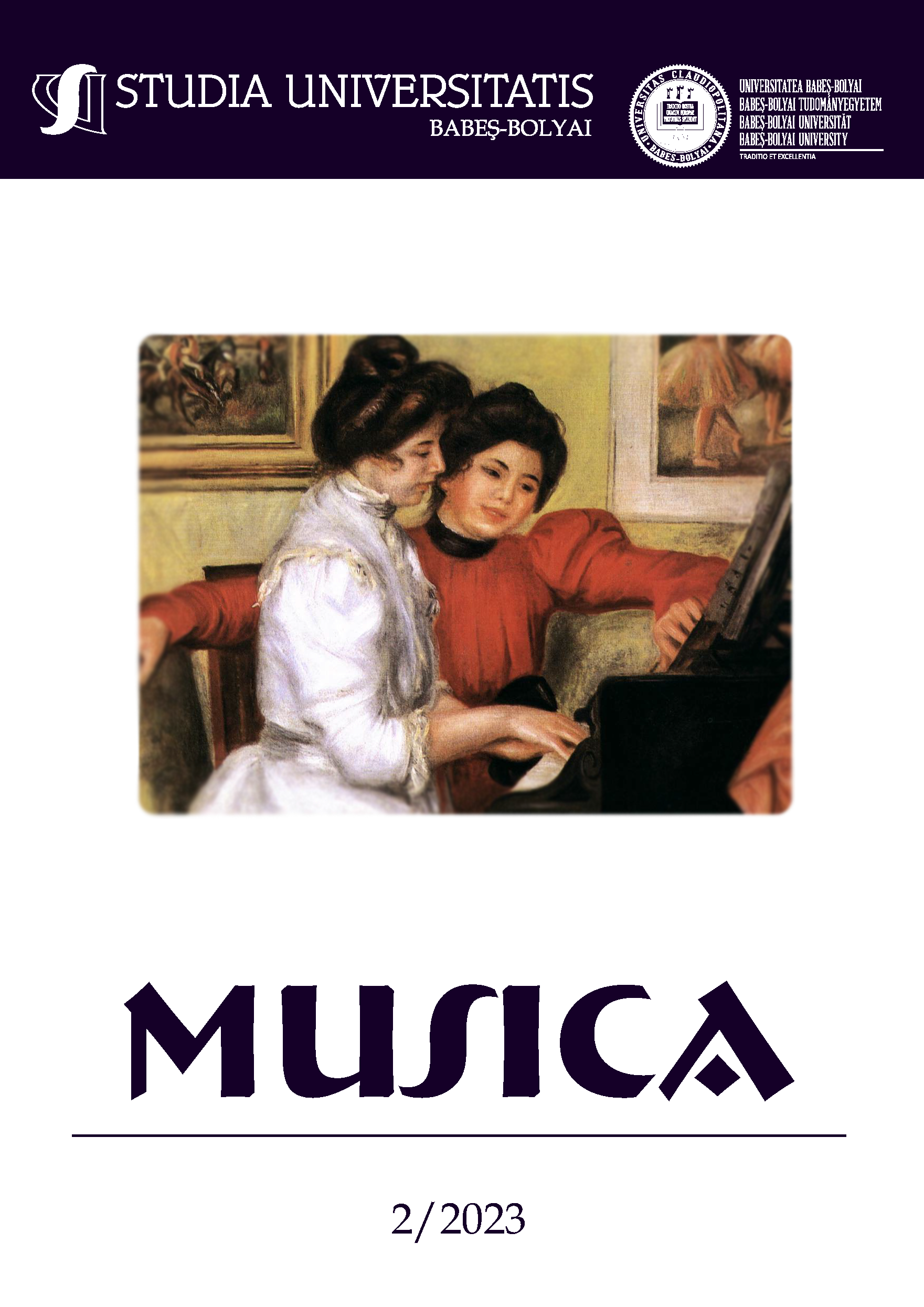Interferences Between Tradition and Modernity in the Symphonic and Concerto Works by Adrian Pop – (2) Etos I
DOI:
https://doi.org/10.24193/subbmusica.2023.2.28Keywords:
folklore, melody, variation, evolution, texturalism, heterophony, spectralism, timbrality.Abstract
The present study is part of a series of analytical approaches undertaken on the symphonic-concertant oeuvre of Cluj composer Adrian Pop. Following the chronological order of the works and keeping as a reference their common source of inspiration – namely the Romanian folklore –, the conclusion seeks to highlight the way in which the composer’s individuality relates to both the trends of contemporary language and the European cultured musical tradition, without attenuating the signs of the local stylistic matrix. Starting from the melody of a Miorița from Sălaj, whose typology will prove crucial in rendering the Blagian concept of the undulating plain, the composer uses traditional means – in particular the timbral essences and effects specific to folk organology – or contemporary techniques such as spectralism, texturalism, heterophony, to capture both the descriptive aspects of the idyllic universe and the archaic, archetypal, timeless and, last but not least, tragic essences of the philosophical and literary source. The symphonic discourse established at the level of the three main sections of the work follows a path of almost organic development, from the cellular-motivic elements that anticipate the Miorița theme, engaged in homogeneous, pulsating, diaphanous, or extremely dissonant textures, to the unique moment of virtuosity of the two semantroms in the central section and, finally, to the display of the original melody in juxtaposition, or superimposition with its inversion, in a tableau dominated by the ascent and descent of the flocks of sheep.References
Banciu, Ecaterina. Archetypal Ethos: „Triptic” (Triptych) by Adrian Pop. In Musica Journal, Studia Universitatis Babeș-Bolyai, Issue no. 2 / 2016
Blaga, Lucian. Trilogia Culturii (The Trilogy of Culture). Humanitas Publishing House, Bucharest, 2011.
Cojocaru, Dora. Folclorul ca sursă de inspirație în școala de compoziție clujeană (The Folklore as an inspirational source for the Cluj composition school), The Academy of Music “Gheorghe Dima”, Cluj-Napoca.
Cozma, Andrei. Texturalismul sau sintonia muzicii din cea de-a doua jumătate a secolului XX. Editura Muzicală, Bucharest, 2019.
Dediu, Dan, Meșteșugarul dibaci: Adrian Pop (The Skilful Artisan: Adrian Pop). In Siluete în mișcare. Eseuri despre compozitori români (Moving Silhouettes. Essays on Romanian Composers). Editura Muzicală, Bucharest, 2021.
Gelman, Sofia. Adrian Pop. In Muzica Journal, no. 2 / 1985.
Hofmann, Alfred. Revenirea lui Vladimir Orlov (The Returning of Vladimir Orlov). In România Liberă, Bucharest, 16.03.1991.
Nemescu, Octavian. Istoria muzicii spectrale (The History of Spectral Music). In Muzica Journal, no. 5 / 2015.
Niculescu, Ștefan. Reflecții despre muzică (Reflections on Music), Editura Muzicală, Bucharest, 1980.
Pop, Adrian. Did George Enescu Know Romanian Folklore? In Folk Music as a Fermenting Agent for Composition, Past and Present, Ed. Bianca Țiplea-Temeș & William Kinderman, Cluj-Napoca, MediaMusica, 2019.
Pop, Adrian. Etos I (Ethos I). The score. Editura Muzicală, Bucharest, 1983.
Popovici, Fred. “Etos I” de Adrian Pop (Ethos I by Adrian Pop). In Muzica Journal, no. 7 / 1979.
Sandu Dediu, Valentina, Muzica românească între 1944-2000 (Romanian Music between 1944-2000). Editura Muzicală, Bucharest, 2002.
Sîrbu, Anca. Adrian Pop sau despre ideal în muzică (Adrian Pop, or about the music ideal). In Actualitatea muzicală Magazine, no. 4 / 2017, Uniunea Compozitorilor și Muzicologilor din România, p. 35.
Șandor, Paula. Aspecte stilistice în creația camerală a compozitorului Adrian Pop (Stylistic aspects in the chamber works of Adrian Pop). MediaMusica Publishing House, Cluj-Napoca, 2022.
Țiplea-Temeș, Bianca, Kinderman, William (ed.). Folk Music as a Fermenting Agent for Composition, Past and Present. MediaMusica, Cluj-Napoca, 2019.
Bibliographical resources provided by the composer:
Pop, Adrian. Etos I for orchestra, Presentation U.C.M.R.
Downloads
Published
How to Cite
Issue
Section
License
Copyright (c) 2023 Studia Universitatis Babeș-Bolyai Musica

This work is licensed under a Creative Commons Attribution-NonCommercial-NoDerivatives 4.0 International License.






